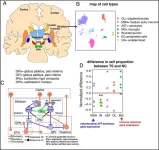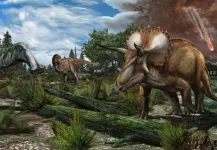(Press-News.org) Philadelphia, April 8, 2025 – In the first comprehensive, cell-by-cell analysis of brain tissue from individuals with Tourette syndrome, researchers have pinpointed exactly which cells are perturbed and how they malfunction, revealing how different types of brain cells are affected by the condition. Findings from this groundbreaking study in Biological Psychiatry, published by Elsevier, provide unprecedented insights into the interplay of different brain cell types in Tourette syndrome, suggesting new therapeutic directions.
What makes this study particularly groundbreaking is that it not only confirms previous findings about the loss of interneurons and inflammatory brain changes in Tourette syndrome but also provides new understanding about how different cell types in the brain interact and influence each other in this disorder.
Lead investigator Flora M. Vaccarino, MD, Child Study Center and Department of Neuroscience, Yale University, Yale Stem Cell Center, and Yale Kavli Institute for Neuroscience, explains, "While previous research using brain imaging has shown that the deep brain nuclei, the caudate-putamen, that are primarily involved in the control of movement programs, are smaller in people with Tourette syndrome, and our prior studies have found a decrease in interneurons in the basal ganglia region, we lacked a comprehensive understanding of exactly how different cell types in these brain regions are affected by the condition.”
In the current investigation the research team analyzed brain tissue samples from six individuals who had severe Tourette syndrome and six matched control subjects without the condition. Using cutting-edge technology that enables the study of individual brain cells, they examined the genes that were expressed in each cell type and the regulatory elements that control gene activity.
Advanced single-cell analysis techniques revealed three key changes in the brains of individuals with Tourette syndrome:
There were about 50% fewer interneurons (specialized brain cells that help regulate the pace of brain electrical activity) in the caudate-putamen region within the basal ganglia, which is crucial for controlling movement. These interneurons normally help down-regulate neuronal activity, and their loss may explain why individuals with Tourette syndrome experience difficulty controlling movements and vocalizations.
The medium spiny neurons, which are the main long-range projection neurons in this brain region, showed signs of metabolic stress, with decreased activity in mitochondrial genes that control cellular energy production.
The immune cells of the brain (microglia) showed increased inflammatory activity, and this inflammatory response was directly correlated with the metabolic stress in the medium spiny neurons. This unexpected relationship suggests these cells are communicating in ways that have not been previously recognized in Tourette syndrome.
Together, these findings create a pattern that may explain why individuals with Tourette syndrome experience involuntary movements and vocalizations.
Co-lead author Yifan Wang, PhD, Department of Quantitative Health Sciences, Center for Individualized Medicine, Mayo Clinic, Rochester, MN, notes, "We found evidence suggesting that these changes in gene activity may be caused by alterations in the regulatory elements that control gene expression, providing new insights into how Tourette syndrome develops and new directions for future research. These findings suggest that the disease may not be caused by defective genes, but rather by improperly switching them on or off during development and lifetime."
Tourette syndrome affects as many as 1 in 150 children. Its primary symptoms are motor and vocal tics, such as eye-blinking or throat clearing that are performed out-of-context and in a repetitive fashion.
Co-lead author Liana Fasching, PhD, Child Study Center, Yale University, remarks, "What makes this research particularly compelling is that despite Tourette syndrome having one of the highest familial recurrence rates among complex neuropsychiatric disorders, large genetic studies have identified only a few risk genes. This suggested to us that we needed to look more deeply at the actual brain tissue to better understand what's happening at a cellular and molecular levels."
John Krystal, MD, Editor of Biological Psychiatry, says, “Current treatments for Tourette syndrome do not address the underlying causes of the condition. This study is particularly timely as it provides new insights into the disorder's biology that point to inhibitory interneuron neuronal and synaptic loss as a key contributing factor to the basal ganglia hyperactivity associated symptoms of Tourette syndrome.”
Dr. Vaccarino concludes: “Our first paper on basal ganglia interneurons of Tourette syndrome was published in 2005, exactly 20 years ago. While there is still much to be learned about the developmental causes of Tourette syndrome, we hope that these findings will inspire new therapeutic trials for individuals affected by this condition.”
END
Groundbreaking study reveals changes in brain cell composition and gene activity in Tourette syndrome
Findings published in Biological Psychiatry provide insights into gene expression and their regulation in all cell types in the basal ganglia of individuals with Tourette syndrome
2025-04-08
ELSE PRESS RELEASES FROM THIS DATE:
ALS drug effectively treats Alzheimer’s disease in new animal study
2025-04-08
Experimental drug NU-9 — a small molecule compound approved by the U.S. Food and Drug Administration (FDA) for clinical trials for the treatment of amyotrophic lateral sclerosis (ALS) — improves neuron health in animal models of Alzheimer’s disease, according to a new Northwestern University study.
Like ALS, Alzheimer’s disease also results from misfolded proteins that damage brain health. Rather than treating symptoms from specific diseases, NU-9 instead addresses the underlying mechanisms of disease. Results from the new study give scientists hope that the drug should demonstrate effectiveness in the common ...
Breakthrough research revolutionizing pulmonary hypertension treatment
2025-04-08
A recent publication in the International Journal of Cardiology, Pulmonary artery denervation in pulmonary hypertension: A comprehensive meta-analysis, has shed light on the potential of pulmonary artery denervation (PADN) as an innovative intervention for pulmonary hypertension (PH), a condition that places patients at risk for right heart failure and death. Co-authored by Dr. James Jenkins, a cardiologist at Ochsner Health, the study analyzed data from multiple clinical trials to assess the therapeutic and clinical impact of PADN ...
More CPR education planned for Charlotte community with The David & Nicole Tepper Foundation
2025-04-08
CHARLOTTE, April 8, 2025 — The American Heart Association and The David & Nicole Tepper Foundation (DNTF) have teamed up to increase bystander cardiopulmonary resuscitation (CPR) and automated external defibrillator (AED) education through the Association’s Nation of Lifesavers™ movement. DNTF’s $600,000 commitment to support training in Charlotte youth sports will help prepare coaches, athletes and sports leagues officials to respond immediately and appropriately in a cardiac emergency situation. DNTF’s gift will also support CPR education within the Mecklenburg County Sheriff’s Department as well as affordable housing communities.
“This ...
When protective lipids decline, health risks increase
2025-04-08
New research from Weill Cornell Medicine has uncovered a surprising culprit underlying cardiovascular diseases in obesity and diabetes—not the presence of certain fats, but their suppression. The study, published Feb. 25 in Nature Communications, challenges the conventional belief that a type of fat called ceramides accumulates in blood vessels causing inflammation and health risks. Instead, their findings reveal that when ceramides decrease in endothelial cells lining blood vessels, it can be damaging and cause chronic illnesses. Ironically, the findings ...
Society for Laboratory Automation and Screening announces $100,000 Graduate Education Fellowship Grant awarded to Vasu Rao of the University of Michigan
2025-04-08
Oak Brook, IL (USA) – The Society for Laboratory Automation and Screening (SLAS) is pleased to announce Vasumitra “Vasu” Rao, M.S., Ph.D. candidate in the Biomedical Engineering program at the University of Michigan (Ann Arbor, Michigan, USA), as the 2025 SLAS Graduate Education Fellowship Grant recipient.
Rao’s innovative work at the intersection of artificial intelligence (AI), laboratory automation and microbiology exemplifies SLAS’s mission to support emerging leaders in quantitative biosciences through the grant.
The awarded funding will enable Rao to continue his research under advisor Paul Jensen, Ph.D. (Assistant Professor of Biomedical Engineering) ...
World’s largest study reveals the long-term health impacts of flooding
2025-04-08
WORLD’S LARGEST STUDY REVEALS THE LONG-TERM HEALTH IMPACTS OF FLOODING
The world’s largest and most comprehensive study of the long-term health impacts of flooding – via analysis of over 300 million hospitalizations records in eight countries prone to flooding events – has found an increased risk of 26 per cent of all diseases serious enough to require hospitalization. This impact on the health of communities lasts up to seven months post event.
The study, led by Monash University researchers, and published in the journal, Nature Water, found that flooding events – which are increasing globally due to climate change ...
A surprise contender for cooling computers: lasers
2025-04-08
ALBUQUERQUE, N.M. — Sandia National Laboratories is helping a tech company test a bright new idea for cooling computers.
Minnesota-based startup Maxwell Labs has entered into a cooperative research and development agreement with Sandia and the University of New Mexico to demonstrate laser-based photonic cooling for computer chips. The company is pioneering the new technology to regulate the temperature of chips, significantly lower the power consumption and increase the efficiency of conventional air and water-based systems.
“About 30 to 40 percent of the energy data centers use is spent on cooling,” said Raktim Sarma, the ...
USPSTF recommendation statement on primary care behavioral counseling interventions to support breastfeeding
2025-04-08
Bottom Line: The U.S. Preventive Services Task Force (USPSTF) recommends providing interventions or referrals, during pregnancy and after birth, to support breastfeeding. The association between breastfeeding and health benefits in children has been previously well established; health benefits have also been found for women who breastfeed. However, breastfeeding rates in the U.S. are relatively modest; as of 2021, 59.8% of infants at age 6 months are breastfed and 27.2% of infants at that age are exclusively breastfed. The USPSTF routinely makes recommendations about the ...
William N. Hait, MD, Ph.D., FAACR, honored with the 2025 AACR-Margaret Foti Award for Leadership and Extraordinary Achievements in Cancer Research
2025-04-08
CHICAGO – The 2025 AACR-Margaret Foti Award for Leadership and Extraordinary Achievements in Cancer Research will be presented to William N. Hait, MD, PhD, Fellow of the AACR Academy, during the AACR Annual Meeting 2025, to be held April 25-30 at the McCormick Place Convention Center in Chicago, Illinois.
Hait served as the global head of Janssen Research and Development and was the executive vice president, chief of external innovation, and medical safety and global public health officer at Johnson & Johnson prior to his retirement in 2024. He is being recognized with this award for his extensive ...
Dinosaurs’ apparent decline prior to asteroid may be due to poor fossil record
2025-04-08
The idea that dinosaurs were already in decline before an asteroid wiped most of them out 66 million years ago may be explained by a worsening fossil record from that time rather than a genuine dwindling of dinosaur species, suggests a new study led by UCL researchers.
The study, published in Current Biology, analysed the fossil record of North America in the 18 million years up to the asteroid impact at the end of the Cretaceous period (between 66 and 84 million years ago).
Taken at face value, these fossils - more than 8,000 of them - suggest the number of dinosaur species peaked about 75 million years ago and then declined in the nine million years leading up to the ...
LAST 30 PRESS RELEASES:
Norbert Holtkamp appointed director of Fermi National Accelerator Laboratory
New agentic AI platform accelerates advanced optics design
Biologists discover neurons use physical signals — not electricity — to stabilize communication
Researchers discover that a hormone can access the brain by hitchhiking
University of Oklahoma researcher awarded funding to pursue AI-powered material design
Exploring how the visual system recovers following injury
Support for parents with infants at pediatric check-ups leads to better reading and math skills in elementary school
Kids’ behavioral health is a growing share of family health costs
Day & night: Cancer disrupts the brain’s natural rhythm
COVID-19 vaccination significantly reduces risk to pregnant women and baby
The role of vaccination in maternal and perinatal outcomes associated with COVID-19 in pregnancy
Mayo Clinic smartwatch system helps parents shorten and defuse children's severe tantrums early
Behavioral health spending spikes to 40% of all children’s health expenditures, nearly doubling in a decade
Digital cognitive behavioral treatment for generalized anxiety disorder
Expenditures for pediatric behavioral health care over time and estimated family financial burden
Air conditioning in nursing homes and mortality during extreme heat
The Alps to lose a record number of glaciers in the next decade
What makes a good proton conductor?
New science reporting guide published for journalists in Bulgaria
New international study reveals major survival gaps among children with cancer
New science reporting guide published for journalists in Turkey
Scientists develop a smarter mRNA therapy that knows which cells to target
Neuroanatomy-informed brain–machine hybrid intelligence for robust acoustic target detection
Eight SwRI hydrogen projects funded by ENERGYWERX
The Lundquist Institute and its start-up company Vitalex Biosciences Announces Strategic Advancement of Second-Generation fungal Vaccine VXV-01 through Phase 1 Trials under $40 Million Competitive Con
Fine particles in pollution are associated with early signs of autoimmune disease
Review article | Towards a Global Ground-Based Earth Observatory (GGBEO): Leveraging existing systems and networks
Penn and UMich create world’s smallest programmable, autonomous robots
Cleveland researchers launch first major study to address ‘hidden performance killer’ in athletes
To connect across politics, try saying what you oppose
[Press-News.org] Groundbreaking study reveals changes in brain cell composition and gene activity in Tourette syndromeFindings published in Biological Psychiatry provide insights into gene expression and their regulation in all cell types in the basal ganglia of individuals with Tourette syndrome




